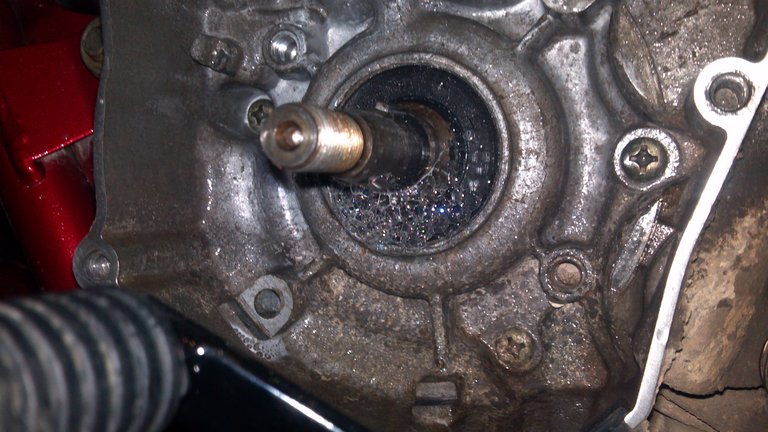To anybody who is curious as to why we stress doing a leakdown test on your engine, here's all the reason you'll ever need:

I'm an experienced mechanic who has been working on engines for years. However, I'm also very human and I DO make mistakes, especially when I get in a hurry. I'll be the first to say that this leak was my fault. I should have used a better method of installing this crank seal when I rebuilt my engine last year, but I rushed it. The seal wasn't driven in squarely, and I eventually paid the price.
Fortunately, it lasted awhile before a leak developed. But the last time I took the Blaster out, it was running "funny" as many might say. Down on power, hanging idle... I took it easy getting back to the truck and trailered the Blaster home half a day earlier than intended. Once home, I pulled out the trusty leak tester and went to work. I kinda suspected a leaky flywheel side crank seal (The Blaster isn't burning any tranny lube and I used an OEM base and head gasket during reassembly), but its nice to see bubbles as confirmation. After I install a new seal, I'll re-test just to be sure its still airtight. And if anybody is wondering, this engine passed a leakdown test right after I got done building it, but the crankshaft wore down the crooked seal just enough over a season of riding to cause a leak.
How's this for a strange way to detect a leaky crank seal?! If only the crankshaft seal was as airtight as this stator cover gasket, we wouldn't be having this problem! Haha.

The moral here is to do an annual leakdown test on your engine, and test more often if you suspect a problem. And, please, DO NOT keep on riding if something suddenly seems "off". Chances are, there is a legitimate problem brewing. BTW, I saved this top end. No scuffing, scoring, or burnt oil is present. Already did a comp test and had the pipe off for an inspection. Safely rich jetting, good oil, and careful riding once the problem developed means my piston lives to rip another day. B)

I'm an experienced mechanic who has been working on engines for years. However, I'm also very human and I DO make mistakes, especially when I get in a hurry. I'll be the first to say that this leak was my fault. I should have used a better method of installing this crank seal when I rebuilt my engine last year, but I rushed it. The seal wasn't driven in squarely, and I eventually paid the price.
Fortunately, it lasted awhile before a leak developed. But the last time I took the Blaster out, it was running "funny" as many might say. Down on power, hanging idle... I took it easy getting back to the truck and trailered the Blaster home half a day earlier than intended. Once home, I pulled out the trusty leak tester and went to work. I kinda suspected a leaky flywheel side crank seal (The Blaster isn't burning any tranny lube and I used an OEM base and head gasket during reassembly), but its nice to see bubbles as confirmation. After I install a new seal, I'll re-test just to be sure its still airtight. And if anybody is wondering, this engine passed a leakdown test right after I got done building it, but the crankshaft wore down the crooked seal just enough over a season of riding to cause a leak.
How's this for a strange way to detect a leaky crank seal?! If only the crankshaft seal was as airtight as this stator cover gasket, we wouldn't be having this problem! Haha.

The moral here is to do an annual leakdown test on your engine, and test more often if you suspect a problem. And, please, DO NOT keep on riding if something suddenly seems "off". Chances are, there is a legitimate problem brewing. BTW, I saved this top end. No scuffing, scoring, or burnt oil is present. Already did a comp test and had the pipe off for an inspection. Safely rich jetting, good oil, and careful riding once the problem developed means my piston lives to rip another day. B)
